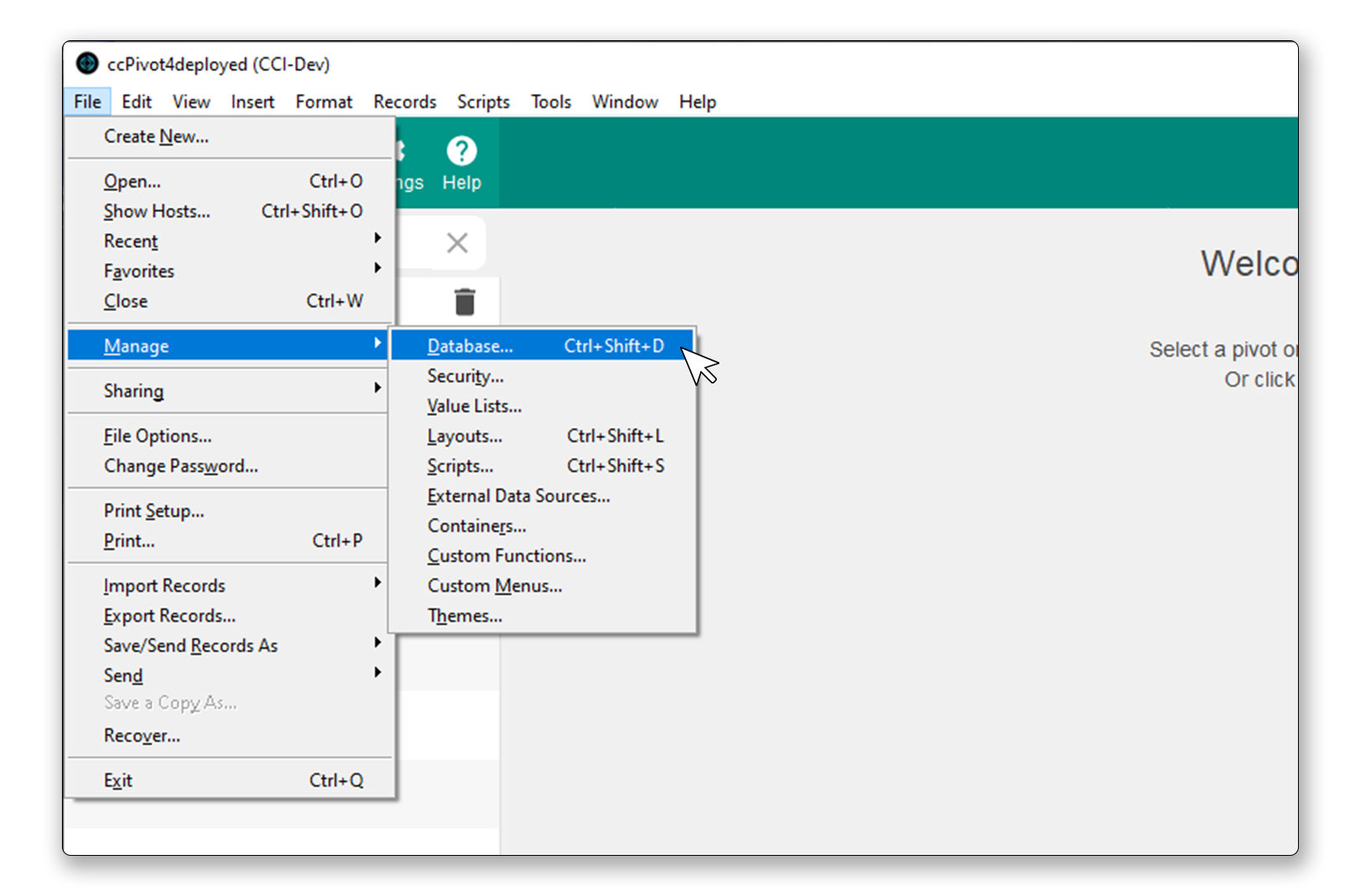¶ Integration
Integrating ccPivot is really very easy. There are just three simple but mandatory steps and one optional one to integrating ccPivot with your existing Filemaker solution, and they are simple enough that anyone can do them in with very little difficulty. First, add your FileMaker Pro file(s) as external data sources in ccPivot; second, add the table occurrence(s) from your file(s) on which you want to run the reports; and third, run the update routine in ccPivot; finally, and optionally, create a layout in the ccPivot file for each data table you are reporting on for displaying detail of your reported summary data. That's all. Below we'll go over each step in a little more detail.
For video assistance you can watch the brief integration video here as well:
- Add your file(s) as external data sources. For any file that has a table you want to report on, you'll need to add an external data source for it to the ccPivot solution.
-
Open ccPivot, and under the "File" menu, selecting the "Manage" sub-menu, and then selecting "External Data Sources...". This will open a new window displaying a list of all existing data sources.

-
Click the "New" button which will open a window allowing you to create a new data source.
-
Click the "Add File..." button, which then prompts you to find the file you want to add to the reporting system. Find your file and select it.

-
Click OK to close each dialog box that has been opened. First step done!
-
- Add your table occurrence(s). You'll need to add a table occurrence for each table that has data for which you want to generate a report.
-
Open the "Database..." Menu under the "Manage" section of the "File" menu, much like in the first step.
-
With the Manage Database window open you want to click on the "relationships" section at the top of the window. This will show you the relationships graph of our CC Pivot system. You do not need to change anything that is already here, you just need to add a table occurrence for your data table.
-
Click the add table occurrence button, select your file under the data source popup in the window that opens, and select the table you want. You should add as many tables as you will want to report on as long as you are in here doing this.

-
Once the table occurrences are added, you can close the manage database window. We're done. You don't need to rename or move them in any way, although if you are like me you may want to clean up your newly added table occurrences so they look tidy. But it's up to you.
-
- Run update routine in ccPivot. ccPivot needs to be refreshed for it to see the tables and data sources you just added.
- This is simple: Just click the Settings button in near the to the left side of the screen to view the settings window, it is the one shaped like a gear.
- Click the "Update Schema" button on the left side near the bottom of the screen. This is on the "Schema Settings" tab, which the system should default to when you go to the settings. The system will get everything ready to go for you.
- You can confirm everything worked properly by reviewing the "Table Name" portal and ensuring your newly added table occurrences are now listed.
- Add new Layouts for each data set you are reporting on. You need to add one layout for each table occurrence you've added that you want to drill down further into the data with the "Record Tracking" feature.
- This is standard FileMaker layout work, you will need to add one layout for each table occurrence you want record tracking to work for.
- Make a new blank layout in ccPivot.
- Select the base table occurrence you are building the layout for in the "Show records from" drop down.
- You can name the layout anything you want, you can also make any sort of layout you want, and include it in the menus or at at your discretion. The pivot table will open the layout automatically when you click on the data in the pivot table when "record Tracking" is turned on. We suggest a list or table style layout as the process of drilling into records can return a large number of records.
- You can complete the layout creation process with any fields or sorting you wish. A script is unnecessary as ccPivot will handle the scripting for you.
- Once the layout is created, go back to the settings screen (it's the gear icon in the upper right on the home screen) and click the "Update My Tables & Layouts" button.
- Click the table occurrence for which you made the layout, and choose the layout you created for it from the portal labeled "Choose Display Layout For Selected Table"
That's it. You're done! Now its time to create your first pivot table.